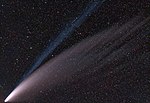astro.wikisort.org - Asteroid
2020 SO[lower-alpha 1] is a near-Earth object identified to be the Surveyor 2 Centaur rocket booster launched on 20 September 1966. The object was discovered by the Pan-STARRS 1 survey at the Haleakala Observatory on 17 September 2020. It was initially suspected to be an artificial object due to its low velocity relative to Earth and later on the noticeable effects of solar radiation pressure on its orbit. Spectroscopic observations by NASA's Infrared Telescope Facility in December 2020 found that the object's spectrum is similar to that of stainless steel, confirming the object's artificial nature.[8] Following the object's confirmation as space debris, the object was removed from the Minor Planet Center's database on 19 February 2021.[9]
 The orbit of 2020 SO around Earth and Sun from Nov. 2020 to Mar. 2021 | |
| Discovery [1][2] | |
|---|---|
| Discovered by | Pan-STARRS 1 |
| Discovery site | Haleakalā Obs. |
| Discovery date | 17 September 2020 |
| Designations | |
MPC designation | 2020 SO |
Alternative designations | P116rK2 [3] |
Minor planet category | NEO · Apollo (May 2020)[4] Atira (Dec 2020)[2] |
| Orbital characteristics [2] | |
| Epoch 17 December 2020 (JD 2459200.5) | |
| Uncertainty parameter 2 | |
| Observation arc | 167 days |
| Earliest precovery date | 19 August 2020 |
| Aphelion | 0.988 AU |
| Perihelion | 0.985 AU |
Semi-major axis | 0.986 AU |
| Eccentricity | 0.00181 |
Orbital period (sidereal) | 0.98 yr (357.9 d) |
Mean anomaly | 276.388° |
Mean motion | 1° 0m 21.877s / day |
| Inclination | 0.1389° |
Longitude of ascending node | 216.656° |
Argument of perihelion | 311.989° |
| Earth MOID | 0.01628 AU (May 2020)[4] 0.00106 AU (Dec 2020) |
| Physical characteristics | |
Mean diameter | 6–12 m (assumed)[5] |
Synodic rotation period | 0.0026080±0.0000001 h[6] or 9.39 s |
Apparent magnitude | 22.4 (at discovery)[1] 14.1 (1 Dec 2020)[7] |
Absolute magnitude (H) | 27.66±0.34[4] 28.43[2] |
Overview
As it approached Earth, the trajectory indicated the geocentric orbital eccentricity was less than 1 by 15 October 2020,[10][lower-alpha 2] and the object became temporarily captured on 8 November when it entered Earth's Hill sphere.[11] It entered via the outer Lagrange point L2 and will exit via Lagrange point L1. During its geocentric orbit around Earth, 2020 SO made a close approach to Earth on 1 December 2020 at a perigee distance of approximately 0.13 lunar distances (50,000 km; 31,000 mi).[4] It also made another close approach on 2 February 2021, at a perigee distance of approximately 0.58 LD (220,000 km; 140,000 mi).[4] Since discovery the time of uncertainty for the February 2021 closest approach to Earth was reduced from ±3 days to less than 1 minute.[4] It left Earth's Hill sphere at around 8 March 2021.[12][lower-alpha 2]

Paul Chodas of the Jet Propulsion Laboratory suspects 2020 SO of being the Surveyor 2 Centaur rocket booster, launched on 20 September 1966.[11][12][13] The Earth-like orbit and low relative velocity suggest a possible artificial object. Spectroscopy may help determine if it is covered in white titanium dioxide paint.[14] Goldstone radar will make bistatic observations transmitting from the 70-meter DSS-14 and receiving at the 34-meter DSS-13.[15] As a result of the bistatic DSS-14/RT-32 radar observations, a rotation period of about 9.5 seconds was obtained,[16] which corresponds to the photometric observations.[6] Obtained range-Doppler radar images[16] confirm that the object has an elongated shape with a length of about 10 meters and a width of about 3 meters.
Around the time of closest approach on 1 December 2020, the object was only brightened to about apparent magnitude 14.1,[7] and required a telescope with roughly a 150mm (6") objective lens to be seen visually.[17] It displays a large light curve amplitude of 2.5 magnitudes, signifying a highly elongated shape or albedo variations on its surface. It has a rotation period of approximately 9 seconds.[18]
At the time of its discovery, 2020 SO had unremarkable motion typical of a main-belt asteroid.[citation needed] However, the four observations that Pan-STARRS obtained over the course of 1.4 hours showed non-linear motion due to the rotation of the observer around Earth's axis, which is a signature of a nearby object.[1][10]
| Parameter | Epoch | Orbit type |
Period (p) |
Aphelion (Q) |
Perihelion (q) |
Semi-major axis (a) |
Inclination (i) |
Heliocentric eccentricity (e) |
Geocentric eccentricity (e)[10][lower-alpha 3] |
|---|---|---|---|---|---|---|---|---|---|
| Units | (years) | AU | (°) | ||||||
| 2020-May-31[4] | Apollo | 1.056 | 1.0722 | 1.0020 | 1.0371 | 0.14061° | 0.03389 | 737 | |
| 2020-Dec-17[2] | Atira | 0.980 | 0.9882 | 0.9847 | 0.9865 | 0.13842° | 0.00180 | 0.89934 | |


In January and February of 2036, it will again approach Earth with a geocentric eccentricity less than 1 since the relative velocities will be small,[10] but will not be within Earth's Hill sphere of 0.01 AU (1.5 million km).[4][lower-alpha 4]
See also
- J002E3 – a near-Earth object discovered in 2002 that was identified as the S-IVB third stage of the Apollo 12 Saturn V rocket
- WT1190F – temporarily orbiting space debris that entered Earth's atmosphere in 2015
- 2018 AV2 – an artificial object discovered in a temporary orbit around Earth in 2018, now suspected to be the Snoopy module from Apollo 10
- 6Q0B44E – another artificial object discovered in orbit around Earth in 2018
- Space debris
- Temporary satellite
Notes
- This was the 14th object ("O") discovered in the first half (period "S") of September 2020. See Provisional designation in astronomy § New-style provisional designation.
- The JPL Horizons On-Line Ephemeris System shows the geocentric orbital eccentricity dropping below 1 by 15 October 2020. But a second condition for capture is that the object is within Earth's Hill sphere which has a radius of roughly 0.01 AU (1.5 million km). Meeting both conditions is when the object is in a temporary satellite capture around Earth.
- Orbital eccentricity must be below 1 to be orbiting the central body.
- An object needs to be within Earth's Hill sphere to truly be in orbit. An object 1AU from Earth could have a geocentric e<1 if the relative velocities are small, but we would not say it is orbiting Earth.
References
- "MPEC 2020-S78 : 2020 SO". Minor Planet Electronic Circular. Minor Planet Center. 19 September 2020. Retrieved 20 September 2020.
- "2020 SO". Minor Planet Center. International Astronomical Union. Archived from the original on 11 February 2021. Retrieved 20 September 2020.
- "2020 SO". NEO Exchange. Las Cumbres Observatory. 18 September 2020. Retrieved 20 September 2020.
- "JPL Small-Body Database Browser: 2020 SO" (2020-12-01 last obs.). Jet Propulsion Laboratory. Archived from the original on 26 January 2021. Retrieved 20 September 2020.
- "NEO Earth Close Approaches". Center for Near Earth Object Studies. Jet Propulsion Laboratory. Retrieved 10 October 2020.
- Peter Birtwhistle (Great Shefford Observatory). "Light curve".
- "2020SO Ephemerides for 1 December 2020". NEODyS (Near Earth Objects – Dynamic Site). Archived from the original on 26 September 2020. Retrieved 26 September 2020.
- Talbert, Tricia (2 December 2020). "New Data Confirm 2020 SO to be the Upper Centaur Rocket Booster from the 1960's". NASA. Retrieved 2 December 2020.
- "MPEC 2021-D62 : DELETION OF 2020 SO". Minor Planet Electronic Circular. Minor Planet Center. 19 February 2020. Retrieved 19 February 2020.
- Horizons output. "Geocentric Orbital Elements for Asteroid (2020 SO)". Retrieved 27 September 2020. ("Ephemeris Type" select "Orbital Elements" · "Center" select 500 for Geocentric. Output lists Eccentricity as "EC".)
- Greicius, Tony (12 November 2020). "Earth May Have Recaptured a 1960s-Era Rocket Booster". NASA. Retrieved 12 November 2020.
- Dunn, Marcia (11 October 2020). "Fake asteroid? NASA expert IDs mystery object as old rocket". phys.org. Retrieved 12 October 2020.
- Harris, Alan (20 September 2020). "Re: another natural satellite of Earth... again". groups.io. Retrieved 20 September 2020.
- B., Mark (12 October 2020). "NASA Expert Believes New "Asteroid" is a Discarded Rocket Part". The Science Times. Retrieved 3 November 2020.
Spectroscopy on the surface of 2020 SO can also determine whether it has titanium dioxide - the paint material used on space rockets.
- "Goldstone Radar Observations Planning: 2020 SO". Asteroid Radar Research. Retrieved 30 November 2020.
- "2020 SO · IAA RAS". iaaras.ru. Retrieved 10 December 2020.
- "Limiting Magnitude". The Wilderness Center Astronomy Club. Retrieved 26 September 2020.
- Masi, Gianluca (2 December 2020). "Near-Earth object 2020 SO: rotation and time-lapse – 01 Dec. 2020". Virtual Telescope Project. Retrieved 2 December 2020.
External links
- "Pseudo-MPEC" for 2020 SO = Surveyor 2 Centaur, Bill Gray, Project Pluto, 31 January 2021
- Earth May Have Recaptured a 1960s-Era Rocket Booster, Tony Greicius, NASA, 12 November 2020
- Animation of the Line of Variation (via clone orbits) stretching out from December 2020 to May 2021
- 01 Dec 2020 image and rotation – Virtual Telescope Project / G. Masi
- 01 Dec 2020 time-lapse and photometry – Virtual Telescope Project / G. Masi
- 2020 SO at NeoDyS-2, Near Earth Objects—Dynamic Site
На других языках
- [en] 2020 SO
[ru] 2020 SO
2020 SO — небольшой околоземный астероид или искусственный объект, открытый в рамках обзора Pan-STARRS1 в обсерватории Халеакала 17 сентября 2020 года. В настоящее время (конец сентября 2020 года) объект приближается к Земле, а его номинальная траектория показывает, что он подвергнется временному захвату Землёй приблизительно 15 октября 2020 года[8]. Объект войдёт в окрестность Земли через точку Лагранжа L2 и выйдет через точку Лагранжа L1. По мере движения по геоцентрической орбите, 2020 SO совершил тесное сближение с Землёй 1 декабря 2020 года при номинальном перигее на расстоянии около 50 тыс. км[6]. Также он совершит другое тесное сближение в феврале 2021 года при номинальном расстоянии в перигее около 220 тыс. км[6]. Момент тесного сближения в феврале 2021 года известен с точностью ±2 дня[6].Другой контент может иметь иную лицензию. Перед использованием материалов сайта WikiSort.org внимательно изучите правила лицензирования конкретных элементов наполнения сайта.
WikiSort.org - проект по пересортировке и дополнению контента Википедии


